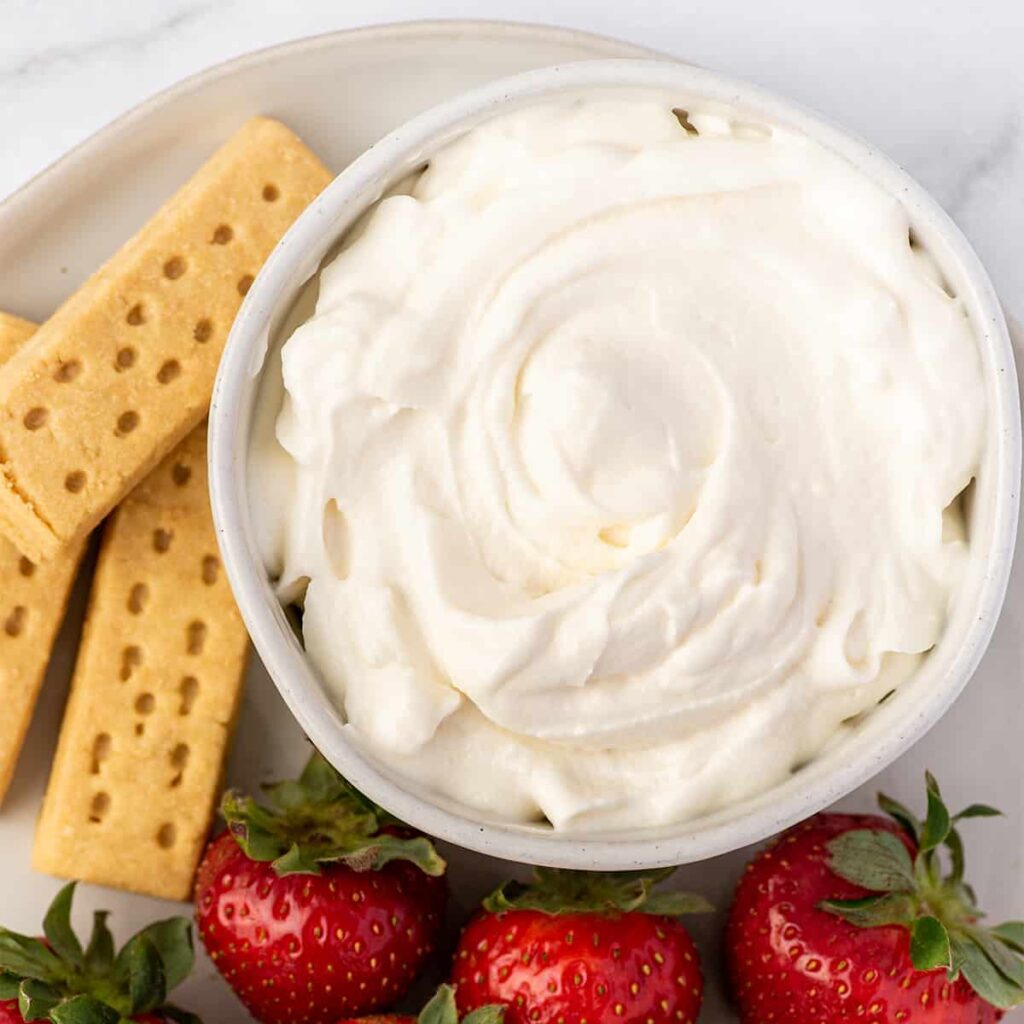What is Cream Cheese? Spread the Love

Cream cheese, a staple in many kitchens around the globe, has long been spreading its creamy goodness on our bagels and adding a velvety finish to our favorite dishes.
But what exactly is this luscious, spreadable delight that has won over so many taste buds?
Let’s delve into the delectable world of cream cheese, exploring its origins, how it’s made, and why it deserves a spot of honor in your refrigerator. Get ready to spread the love for cream cheese, a culinary hero that’s much more than just a bagel’s best friend!
Quick Facts About Cream Cheese
| Quick Facts | Description |
|---|---|
| Origin | The modern version of cream cheese was first made in the United States in the 19th century. It became popular due to its mild taste and smooth texture. |
| Production Process | Cream cheese is made from a mixture of cream and milk. The mixture is heated until curds form, then it is drained and cooled. The remaining product is beaten into a smooth, creamy consistency. |
| Taste | Cream cheese has a mild, slightly tangy flavor which makes it versatile for both sweet and savory uses. |
| Texture | It has a smooth, creamy, and spreadable texture. |
| Nutritional Value | Cream cheese is high in fat and calories but also contains a good amount of vitamin A and contributes to your daily protein intake. |
| Common Uses | It’s often used as a spread on bagels and toast, an ingredient in cheesecakes and frostings, or as a dip for fruits and vegetables. |
| Variations | There are several variations of cream cheese, including whipped cream cheese, which has air whipped into it to make it lighter and spreadable, and Neufchâtel, a lower-fat version. There are also flavored varieties like strawberry or chive & onion. |
| Shelf Life | Unopened cream cheese can last for several weeks past its “sell by” date when stored in the refrigerator. Once opened, it should be used within two weeks. |
What is Cream Cheese?
Cream cheese is a culinary chameleon, a star player in a wide variety of dishes that span from breakfast to dessert. Originating from the United States in the 19th century, it has since become a staple in kitchens around the globe.
At its core, cream cheese is a fresh cheese made from a blend of milk and cream. The mixture is heated until curds form, which are then drained and cooled. The result? A smooth, creamy delight with a slightly tangy flavor that has the power to elevate any dish it graces.
But what truly sets cream cheese apart is its versatility. With its mild flavor and delectable creaminess, it can morph into a sweet cheesecake, a savory bagel spread, a velvety pasta sauce, or even a decadent frosting. It’s this adaptability that has solidified cream cheese’s spot on our grocery lists.
There are also numerous variations of cream cheese to explore. From the lighter, air-whipped version to the lower-fat Neufchâtel, and an exciting range of flavors like strawberry or chive & onion, there’s a cream cheese for every palate and purpose.
So next time you savor a slice of red velvet cake, enjoy a bagel smeared with this creamy spread, or bite into a jalapeño popper, take a moment to appreciate the wonder that is cream cheese. It’s more than just a dairy product—it’s a testament to the magic of simple ingredients and culinary innovation.
What Does Cream Cheese Taste Like?

Cream cheese is known for its distinct, yet subtle flavor profile. It has a mild, creamy taste with a slight tanginess that adds a spark of freshness. This balance of flavors makes cream cheese a versatile ingredient, blending well with both sweet and savory dishes.
The texture also plays a part in the overall taste experience of cream cheese. Its smooth and velvety consistency can make dishes feel luxurious and indulgent. When spread on a warm bagel or a crisp slice of toast, it melts slightly, enhancing its rich, creamy flavor.
In flavored varieties of cream cheese, like strawberry or chive & onion, the base taste remains the same, but there’s an additional layer of flavor. For example, strawberry cream cheese maintains the familiar creamy and tangy profile but also has a sweet, fruity note. On the other hand, a chive & onion cream cheese variation would add a savory, slightly pungent flavor to the mix.
But despite its unique flavor, cream cheese doesn’t overpower the tastes of other ingredients. Instead, it harmonizes with them, providing a creamy backdrop that allows other flavors to shine. This is why it’s a favored ingredient in dishes ranging from cheesecakes to pasta sauces to dips.
Cream Cheese Tasting Notes
- Mild Flavor: Cream cheese has a mild flavor that makes it versatile in both sweet and savory dishes.
- Slightly Tangy: There’s a slight tanginess to cream cheese that adds a fresh and bright note, balancing out its creamy richness.
- Creamy and Rich: The texture of cream cheese contributes to its taste. It’s creamy and rich, adding a luxurious feel to dishes.
- Subtle Sweetness: Some might detect a subtle sweetness in cream cheese, particularly when it’s used in desserts like cheesecake or frosting.
- Versatile Base: The flavor of cream cheese is subtle enough to act as a canvas for other ingredients. It can easily be flavored with sweet elements like fruit or chocolate, or savory ones like herbs and spices.
- Flavored Varieties: Flavored cream cheeses present the same base taste but with added notes. For example, strawberry cream cheese carries a sweet, fruity flavor, while chive & onion cream cheese imparts a savory, slightly pungent taste.
- Melts Well: When heated or spread on warm food, cream cheese melts slightly, enhancing its rich, creamy flavor.
- Harmonious: Despite its distinct taste, cream cheese doesn’t overpower other flavors. Instead, it works harmoniously with them, providing a creamy backdrop that allows other tastes to shine.
What is Cream Cheese Used for?

- Spread: Cream cheese is often used as a spread on bagels, toast, and crackers.
- Dips: It’s the base for many dips, such as spinach and artichoke dip or buffalo chicken dip.
- Baking: Cream cheese is a key ingredient in cheesecakes, and it’s also used in other baked goods like pastries, muffins, and cookies.
- Frosting: Its creamy texture and mild flavor make cream cheese perfect for frosting cakes and cupcakes, especially red velvet and carrot cake.
- Sauces: Cream cheese can be melted into sauces to add richness and creaminess. It’s often used in pasta sauces, enchilada sauce, and more.
- Stuffed Foods: It’s commonly used as a filling in foods like jalapeno poppers, stuffed chicken breasts, and sushi rolls.
- Desserts: Beyond cheesecake, cream cheese is used in a variety of desserts, including cream cheese bars, chocolate truffles, and sweet dips.
- Soups: Some recipes use cream cheese to thicken and enrich soups.
- Salad Dressings: Cream cheese can be used to create thick, creamy salad dressings.
- Mashed Potatoes: Adding cream cheese to mashed potatoes makes them extra creamy and flavorful.
How is Cream Cheese Different from Cheese?
Cream cheese and other types of cheese like Cheddar, Swiss, or Brie differ in several ways, including the ingredients used, the production process, and their characteristics.
Here’s a detailed comparison:
- Ingredients: Cream cheese is made from a mixture of cream and milk, while other cheeses are typically made from milk alone. The addition of cream gives cream cheese its high-fat content and smooth, creamy texture.
- Production Process: The process of making cream cheese involves adding a starter culture to the cream and milk mixture to encourage fermentation. The mixture is then heated and left to coagulate. The curds are drained but not pressed, which results in a soft, spreadable texture. Other cheeses, like Cheddar or Brie, undergo a more complex process that includes curdling the milk, cutting and cooking the curd, draining the whey, and then pressing and aging the cheese.
- Aging: Unlike many types of cheese which are aged to develop flavor, cream cheese is not aged at all. This gives it a mild, slightly tangy flavor compared to the more robust flavors of aged cheeses.
- Texture: Cream cheese has a soft, spreadable texture, while other cheeses can range from semi-soft (like Brie) to hard (like Parmesan).
- Usage: Due to its creamy texture and mild flavor, cream cheese is often used as a spread on bagels and in baking (for example, in cheesecakes). Other cheeses can be used in a variety of ways, including in cooking, as a topping for crackers, or on their own as part of a cheese board.
- Shelf Life: Cream cheese has a shorter shelf life and should be consumed within a few weeks of opening. Hard cheeses, on the other hand, can last for several months if stored properly.
Is Cream Cheese Healthy?

Health Benefits:
- Source of Vitamin A: Cream cheese is a good source of Vitamin A, which supports eye health and boosts the immune system.
- Low in Lactose: Compared to other dairy products, cream cheese contains less lactose, making it a suitable option for people intolerant to lactose.
- Contains Antioxidants: Cream cheese comprises numerous antioxidants and carotenoids, which help neutralize harmful free radicals in the body and protect against cell damage.
- Probiotic Effects: Some types of cream cheese may contain beneficial strains of bacteria that can promote gut health.
- Lower in Sodium and Saturated Fats: Compared to harder cheeses like cheddar, cream cheese usually contains less sodium and saturated fats.
Potential Downsides:
- High in Calories and Fat: Regular cream cheese can be high in calories and fat. For instance, two tablespoons of regular cream cheese have around 100 calories and 9 grams of fat.
- Limited Nutrients: While cream cheese does contain some vitamins and minerals, its overall nutrient profile is not as rich as other foods or even other types of cheese.
- Contains Saturated Fats: Despite being lower in saturated fats than some other cheeses, cream cheese still contains these fats, which should be limited in a healthy diet to prevent heart disease.
As with any food, moderation is key. If you’re watching your calorie or fat intake, opt for light or whipped cream cheese, which typically contains fewer calories and less fat than regular cream cheese. Also, there are healthier plant-based alternatives available in the market.
Is Cream Cheese Better than Butter?
| Cream Cheese | Butter | |
|---|---|---|
| Calories (per 100g) | Approximately 342 calories | Approximately 717 calories |
| Fat Content (per 100g) | About 34 grams (20 grams of which are saturated fats) | About 81 grams (51 grams of which are saturated fats) |
| Protein (per 100g) | Approximately 6 grams | Approximately 1 gram |
| Carbohydrates (per 100g) | Approximately 4 grams | Trace amounts |
| Vitamin A | Good source | Excellent source |
| Lactose | Lower in lactose, making it a potentially better option for those with lactose intolerance | Contains lactose, which can be problematic for those with lactose intolerance |
| Cholesterol (per 100g) | Approximately 110 mg | Approximately 215 mg |
| Sodium (per 100g) | Approximately 321 mg | Approximately 643 mg |
| Use in Cooking/Baking | Used as a spread, in baking (like cheesecakes), and in sauces | Used in baking, frying, sautéing, and as a spread |
While both cream cheese and butter have their own nutritional profiles, neither should be consumed excessively due to their high calorie and fat content.
The choice between the two often depends on individual dietary needs, personal preference, and the specific culinary application. Always choose organic, grass-fed dairy products when possible, as they are typically higher in nutrients.
Why is Cream Cheese so tasty?

Cream cheese is considered tasty due to these 5 factors:
- Fat Content: Cream cheese has a high-fat content, which is known to enhance the taste of food. Fat carries flavor and creates a smooth, creamy texture that is pleasing to the palate.
- Mild Flavor: Cream cheese has a mild, slightly tangy flavor that pairs well with both sweet and savory ingredients. This versatility makes it a popular choice in various dishes, from bagels to cheesecakes.
- Salt: Like many other cheeses, cream cheese contains salt, which is a flavor enhancer. The saltiness of cream cheese can make it more appetizing and satisfying.
- Texture: The smooth and spreadable texture of cream cheese can also contribute to its tasty appeal. It spreads easily on a variety of foods and blends well into sauces and fillings, contributing to the overall sensory experience of eating.
- Lactic Acid: During the production of cream cheese, lactic acid bacteria are added to the milk and cream mixture. These bacteria ferment lactose (the sugar in milk) into lactic acid, giving cream cheese its characteristic tangy flavor.
What are the Different Types of Cream Cheese
| Type of Cream Cheese | Description |
|---|---|
| Regular Cream Cheese | This is the most common type of cream cheese, known for its rich, creamy texture and mild tangy flavor. It’s used in a variety of dishes, from spreads to baking. |
| Whipped Cream Cheese | This type of cream cheese has air whipped into it, making it lighter and more spreadable. It has fewer calories and less fat per serving than regular cream cheese due to its increased volume. |
| Neufchâtel | Originating from France, Neufchâtel is a soft cheese that’s similar to cream cheese but made with milk instead of cream, resulting in lower fat content. In the U.S., some brands label their lower-fat cream cheese as “Neufchâtel”. |
| Low-fat or Light Cream Cheese | This is a version of cream cheese that’s made with less fat than the regular variety. The taste and texture may be slightly different due to the reduced fat content. |
| Non-fat Cream Cheese | Made without any fat, this type of cream cheese has a different texture and flavor compared to regular cream cheese. It’s often used by those looking to reduce their fat intake. |
| Double Cream Cheese | This is a richer version of cream cheese, made with a higher proportion of cream. It’s thicker and creamier than regular cream cheese. |
| Flavored Cream Cheese | These are cream cheeses that have flavors added to them, such as herbs, fruits, spices, or even sweet elements like chocolate or caramel. They’re often used as spreads or in specific recipes. |
How to Soften Cream Cheese?
Softening cream cheese is crucial for several recipes, especially those that require a creamy, smooth texture.
Here are 3 different methods you can use to soften cream cheese:
- Room Temperature: The easiest way to soften cream cheese is to let it sit at room temperature. However, this method requires some planning as it could take up to an hour for the cream cheese to reach the desired softness.
- Warm Water: A quicker way to soften cream cheese is to use warm water. For this method, remove the cream cheese from its cardboard packaging but keep it in its foil wrapping. Submerge the wrapped cream cheese block in a bowl of warm water. It should soften in several minutes.
- Microwave: If you’re in a hurry, you can also soften cream cheese in a microwave. Place the unwrapped cream cheese on a microwave-safe plate and heat it on high for 15 seconds. If it’s not soft enough, continue microwaving in 10-second intervals until it reaches the desired softness.
Remember to be careful while using the microwave or warm water methods to avoid overheating or melting the cream cheese.
The ideal consistency of softened cream cheese should be smooth and easy to spread but still hold its shape.
As for food safety precautions, cream cheese should not be left out at room temperature for more than two hours to prevent bacterial growth.
Best Cream Cheese Substitutes
| Cream Cheese Substitute | Explanation |
|---|---|
| Greek Yogurt | Greek yogurt can be used as a healthier substitute for cream cheese in many recipes due to its creamy texture and tangy flavor. It’s lower in fat and calories but higher in protein. |
| Cottage Cheese | Cottage cheese can provide a similar texture to cream cheese when blended. It’s lower in fat and has a mild flavor, making it a good substitute in savory dishes. |
| Ricotta Cheese | Ricotta cheese has a similar consistency to cream cheese, though it’s lighter and less tangy. It works well in sweet and savory dishes that call for a creamy, mild cheese. |
| Mascarpone Cheese | This Italian cheese is rich and creamy like cream cheese, but it has a sweeter and less tangy flavor. It’s a great substitute in desserts or sweet recipes. |
| Neufchâtel Cheese | This cheese is very similar to cream cheese but contains less fat. It’s a direct substitute and can be used in any recipe that calls for cream cheese. |
| Sour Cream | Sour cream can be used as a substitute for cream cheese in recipes where the tangy flavor fits, such as dips or sauces. However, it’s less thick and creamy. |
| Tofu (Silken or Soft) | Tofu can be used as a vegan substitute for cream cheese. When blended, it takes on a creamy texture similar to cream cheese. It’s lower in fat and can take on the flavors of other ingredients in the recipe. |
Top 7 Cream Cheese Brands
| Rank | Brand | Key Nutritional Benefits |
|---|---|---|
| 1 | Philadelphia Whipped Cream Cheese Spread | Lower in fat and calories than regular cream cheese due to the whipping process. It also has a light, airy texture. |
| 2 | Kite Hill | Known for its plant-based cream cheese alternatives that are dairy-free, soy-free, and gluten-free. High in protein and fiber. |
| 3 | Miyoko’s | Offers vegan cream cheese that is made with organic ingredients and free from cholesterol. |
| 4 | Tofutti | Provides dairy-free cream cheese alternative which is lower in fat and high in protein. |
| 5 | 365 by Whole Foods | Offers an organic option that is free from artificial preservatives, colors, and flavors. |
| 6 | Clover Sonoma | Known for its organic cream cheese that is made with milk from cows not treated with the artificial growth hormone rBST. |
| 7 | Tillamook | Known for its high-quality dairy products, Tillamook’s cream cheese is made with simple, all-natural ingredients and is a good source of protein. |
What Pairs Well With Cream Cheese?
Food that goes well with Cream Cheese:
| Category | Foods That Pair Well With Cream Cheese |
|---|---|
| Breads & Grains | Bagels, crackers, sandwiches, pizza, pasta |
| Fruits | Berries, grapes |
| Vegetables | Bell peppers, cucumbers, roasted peppers, scallions |
| Protein | Bacon, crab (in baked crab dip), roasted pork tenderloin |
| Desserts | Cupcakes, ice cream, brownies |
| Herbs & Spices | Fresh herbs, basil pesto |
| Other | Pimento cheese, miso spread, macaroni and cheese, tomato soup, sour cream flavored potato chips |
Beverage that goes well with Cream Cheese
| Category | Beverages That Pair Well With Cream Cheese |
|---|---|
| Tea | Peach Cream Cheese Tea, Chai Tea |
| Coffee | Regular coffee pairs well with cream cheese especially in desserts |
| Milkshakes/Smoothies | Raspberry Cheesecake Milkshake, Cream Cheese Foam Strawberry Smoothie |
| Non-Alcoholic Drinks | Lemonade, Soda, Drinking chocolate |
| Specialty Drinks | Orange Honey Cream Cheese Drink, Pumpkin Cream Cheese Drink |
The History and Origin of Cream Cheese

Cream cheese is a popular dairy product known for its smooth texture and mild flavor, often used in both sweet and savory dishes.
The origin of cream cheese can be traced back to Europe, but the version we know today is distinctly American.
In Europe, similar cheeses had been made for hundreds of years but were typically produced using whole milk. The American innovation was the addition of cream to the process, giving the cheese its rich, creamy texture and distinctive taste.
The creation of modern cream cheese is often attributed to William Lawrence, a dairyman from Chester, New York, in 1872. Lawrence was attempting to recreate a French cheese called Neufchâtel. He ended up creating an “unripened cheese” that was richer and creamier due to the higher fat content from the cream he used.
Lawrence began commercially distributing his new cheese, wrapping it in foil to maintain freshness. In 1880, he adopted the brand name “Philadelphia,” which was then considered synonymous with high quality, as the city was known for its top-notch food and ingredients.
In 1903, the Phoenix Cheese Company bought Lawrence’s business and with it, the Philadelphia trademark. In 1928, the Kraft Cheese Company acquired Phoenix, and thus, the Philadelphia Cream Cheese brand. Today, Philadelphia is one of the most recognized cream cheese brands worldwide.
Over time, cream cheese has become a staple in many dishes, from bagel spreads to cheesecakes, and continues to be a beloved ingredient in kitchens around the world.
Frequently Asked Questions
1. Can I eat Cream Cheese directly?
Yes, you can eat cream cheese directly. It’s safe to consume straight from the package and doesn’t require any specific preparation. However, its rich and creamy flavor is often enhanced when paired with other foods like bagels, fruits, or used in recipes.
2. Is Cream Cheese good on toast?
Yes, cream cheese is delicious on toast. Its creamy texture and mild flavor complement the crispiness of the toast well. It’s a popular choice for a simple, satisfying breakfast or snack.
3. Can I freeze Cream Cheese?
Yes, you can freeze cream cheese, but it’s important to note that the texture may change as a result. Freezing cream cheese can make it more crumbly and less creamy once thawed. This makes it less ideal for spreading on bagels or crackers, but it can still work well in cooked dishes like casseroles, soups, or baked goods where the change in texture won’t be as noticeable.
To freeze cream cheese, it should be wrapped well in plastic wrap or placed in a freezer-safe container to prevent freezer burn. It can be frozen for up to two months. To use, allow it to thaw in the refrigerator.
Also read:
- Queso Fresco: A Delightful Journey through its Complex Flavors
- All About Roquefort: An Insider’s Guide to the King of Blue Cheese
- Asiago Cheese: An In-depth Exploration of Nutrition and Taste
- Queso de Bola: The Classic Cheese of Celebrations
- What is American Cheese? The Controversial Delight of the Dairy World
- Emmental: A Comprehensive Guide to Switzerland’s Cheese Haven
- The Ultimate Guide to Kasseri: A Taste of Tradition





